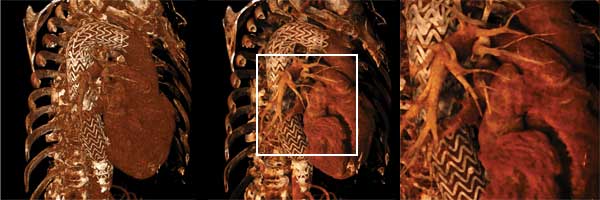
Joel Kronander, Daniel Jönsson, Joakim Löw, Patric Ljung,
Anders Ynnerman, Jonas Unger
Linköping University Siemens Coorporate Research
IEEE Transactions on Visualization and Computer Graphics,
(TVCG), 2011

[High resolution version.]
Abstract:
We present an algorithm that enables real-time dynamic shading in direct volume rendering using general lighting, including directional lights, point lights and environment maps. real-time performance is achieved by encoding local and global volumetric visibility using spherical harmonic (SH) basis functions stored in an efficient multi-resolution grid over the extent of the volume. Our method enables high frequency shadows in the spatial domain, but is limited to a low frequency approximation of visibility and illumination in the angular domain. In a first pass, Level Of Detail (LOD) selection in the grid is based on the current transfer function setting. This enables rapid on-line computation and SH projection of the local spherical distribution of visibility information. Using a piecewise integration of the SH coefficients over the local regions, the global visibility within the volume is then computed. By representing the light sources using their SH projections, the integral over lighting, visibility and isotropic phase functions can be efficiently computed during rendering. The utility of our method is demonstrated in several examples showing the generality and interactive performance of the approach.
Keywords: Volumetric Illumination, Precomputed Radiance Transfer, Volume Rendering
Documents:
TVCG Paper Pre-print (.pdf)
Supplementary Video (.mov)
Acknowledgements:
We gratefully acknowledge Stefan Lindholm, Stefan Gustavsson, Tan Khoa Nguyen, Per Larsson, Frida Hernell and Erik Sunden for invaluable discussions. We would also like to thank the anonymous reviewers for their feedback. A special thank you goes to Matt Cooper for proofreading the manuscript. This work was supported through the Swedish Foundation for Strategic Research through the strategic research centre MOVIII grant A3:05:193, the Swedish Knowledge Foundation grant 2009/0091, Forskning och Framtid grant ITN 2009-00116, the Swedish Research Council through the Linnaeus Center for Control, Autonomy, and Decision-making in Complex Systems (CADICS), and the Excellence Center at Linköping and Lund in Information Technology (ELLIIT).
|
Jonas Unger 2019 |